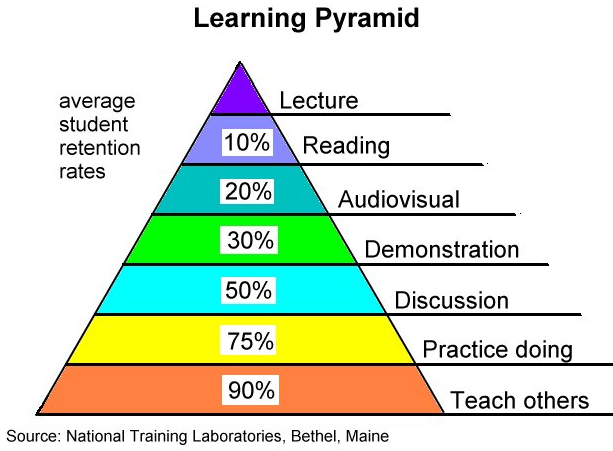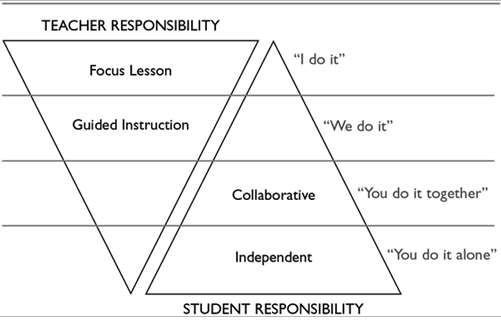Today I participated the method class by Dr. Luft and responsed to her question “How students learn best? by rehearing something, learning the vocabulary, or by doing science”.
My response was: the answer was obvious doing science will let student learn most, but if we take out of the word “best”, all approaches can help student learn in special situations.
I know it is a little misleading and I am afraid that some students in the classroom might misunderstood me. Well, by saying that, I don’t mean we should really repeat our explanations to students again and again or let students master only vocabularies or terms. But I do want say we should not put ‘lecture’ on the opposite side of ‘inquiry’. I also want to point out that we should be very careful to use these two words to label teaching practices, especially those of student teachers.
Well, lecture, You can lecture; Some teacher is only able to lecture. But if you decide to use lecture, try to do it good. Because lecture can be totally different styles and outcomings.
It is interesting – we did not teach student teachers how to lecture, although this conception exist in their mind, and they are very likely to use this approach in the beginning of their carriers – isn’t it.
Ok, let’s do lecture.(really?)
There are different levels of lectures.
- Some teacher just stands there and say something, whether related or not. Student are very easily lost interests and get boring and then sleeping. Sometime they appear awake, but their mind are sleep.
- Some teacher stand there say something interesting, student are engaged and listen carefully, some can even retell the interesting stories to others. It is better, right.
- Some stand there say something putting students on uncomfortable positions, let students think critically about the dilemma or issues and discuss with each other, which may have a profound impact on what students believe and act in the future.
Some lecturer also do some performance or something tricky or funny; Some lecture even let audience participate, here is a example of TED lecture: the art of misdirection. Whether lecture or inquiry, they are just labels. Label itself can not guarantee your teaching quality and students’ learning outcomes. We should keep this in mind.
In fact, what teachers can do and only do is create learning opportunity by engaging student in learning activities. Student learn new knowledge through their learning experience. But, different learning experience have different consequences. The following is the learning pyriod.
You can see from the picture above, student can sit and listen, learn by listening and reading. This process just get information into their short term memory not long term memory. So they may just listen and forget, rarely transfer the new knowledge into new situations.
They can also study by doing science,trying to figure out questions such as what can I do with this stuff ? How to relate all these stuff? What data to collect? How to collect? What is happening? What is going to happen? Why it happen? Why it doesn’t happen? and so on. This approach not only work on the working memory, but also interact with the long term memory – their prior ideas and conceptual frameworks. They have to recall what they had learned and experienced in order to solve all these problems.
In the learning pyramid, the most effective way is learning by teaching,just as what the student teacher are doing now. Usually we suppose student teachers already have enough content knowledge for teaching the topic, but it is not true. Many studies showed that beginning teachers’ content knowledge are usually Fragmented and less connected, it was also structured for doing test not teaching.1 Maybe it is enough for exam but not enough for teaching.
Inquiry research showed that good inquiry are significantly better than lecture, but it has a precondition – the teacher have good knowledge ground.2 Carlsen (1991) reported that when teaching self-identified high knowledge topics, teacher were more likely to ask more high level questions than teaching low knowledge topics.3 But student teachers usually lack of this ground, they are struggling with integrating inquiry into their lessons. It is not an easy thing achieved overnight, but a step by step continuing process.
Recently, I read a book review Learning,or not Learning,in school. The author of the book argued teacher can not give a model or demonstration, and then let student follow the model to do on their own(the mistake I also made in my teaching). There should be some middle stages, such as discussing or doing together or let students do it collaborative, before let them do it by their own. The big idea is Gradually ownership shifting, or gradual release of responsibility. It is not a new idea, but I like it.
This picture is from: Learning,or not Learning,in school
As you can see in the picture, the middles stages Guided Instruction(we do it) and Collaborative(you do it together) sometimes is missing our teaching. This may explain why students can’t do it well as teacher expected, because the learning process is too sharp.
Why I want to highlight the point that DO NOT put lecture in the opposite position of Inquiry, I have other concerns. Try to think:
What happen if student teacher believe in inquiry but can not do it well?
==>They drop out. Because they tend to believe themselves not suitable for teaching.
Another extreme concern is:
What happen if teacher only believe lecture and only one direction approach?
==>They refuse to change and can’t do a good job,finally they may drop out.
Usually, student teacher know they should do inquiry or make their class more interactive, but they are just not able to do it or feel too hard to do it. Why this happen? What to do with this? If this doesn’t change, they will form a belief that inquiry doesn’t suit them or their teaching. It is a hot potato. Well one possible approach to this problem is “we do it together”.
We were taught to not label students, right? We also should avoid to label teachers. Abused labels can cause problems even disasters, for example, students who labeled themselves as visual learner would say, I can’t learn very well because the teacher used very little pictures, simulations. Really? In fact, the label just limit students’ learning approaches instead of expand their ways of learning. Good learner should use every possible way to learn and develop skills respectively.
Who should take the responsibility for learning? Teacher? Students? Or both? Or the responsibility gradually shift from teacher to students?
What strategies or methods are suitable for this shifting?
These are the questions that are worth to think over.
References:
[1] Hauslein, P. L., Good, R. G., & Cummins, C. L. (1992). Biology content cognitive structure: From science student to science teacher. Journal of Research in Science Teaching, 29(9), 939-964.
[2] Blanchard, M. R., Southerland, S. A., Osborne, J. W., Sampson, V. D., Annetta, L. A., & Granger, E. M. (2010). Is inquiry possible in light of accountability?: A quantitative comparison of the relative effectiveness of guided inquiry and verification laboratory instruction. Science Education, 94(4), 577-616.
[3] Carlsen, W. S. (1991). Effects of new biology teachers’ subject‐matter knowledge on curricular planning. Science Education, 75(6), 631-647.

